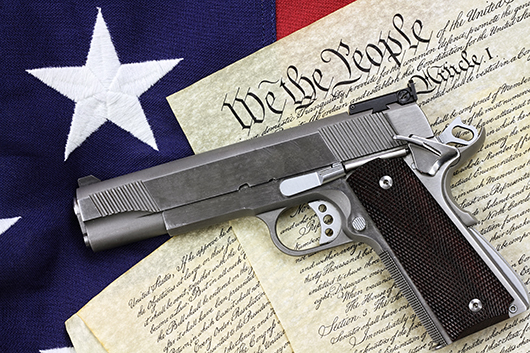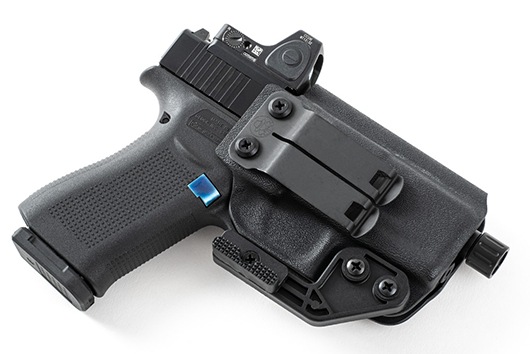How to Choose a 1911 IWB Holster For Concealed Carry
Mar 2nd 2021

The 1911 pistol is the quintessential American firearm and one of the most popular handgun designs available on the market today. Many people find that even full-size models are suitable for concealed carrying, finding the gun’s relatively thin profile more comfortable than typical double-stack pistols. If this describes you and you’re looking for a suitable concealed carrying holster, find out what your options are and which ones are the best for you.
Holster Types

Although there are many types of holsters on the market, it is critical to differentiate each type’s pros and cons. Using the right holster for the right carry situation ensures your safety and that of others.
IWB and OWB Holsters
The two most common types of 1911 holsters are inside the waistband holsters (IWB) and outside the waistband holsters (OWB).
IWB holsters are the best category of holsters for concealed carrying. Holsters in this configuration ride on your waistband using belt loops and belt clips sized for your gun belt. They provide deep concealment when hidden under your shirt and waistband, limiting the risk of printing or accidentally revealing your handgun to other people.
Although OWB holsters offer better retention and comfort, particularly for relatively heavy handguns such as a full-size 1911, they ride on the outside of your waistband, making them harder to conceal effectively. Although it is possible to conceal a holster outside the waistband with the right choice of attire and cover garments, OWB holsters are better suited for open carry.
Other Holster Types
Less common types of holster designs include paddle holsters and belly-band holsters.
Paddle holsters are a type of OWB holster that uses a paddle system instead of a belt clip. The paddle makes it easy and convenient to install and remove on your belt. However, the additional bulk makes it even more challenging to conceal effectively than a traditional OWB holster. Paddle holsters are not recommended for carrying a 1911 concealed because they simply can’t be hidden as effectively as an IWB holster.
Belly-band holsters employ large bands of elastic, stretchy material. This holster type allows you to carry a handgun concealed without the need for a gun belt, commonly selected by women, active individuals, and people who generally do not find traditional holsters to be comfortable to wear. However, due to the materials used, they tend not to protect your handgun against sweat and moisture, requiring you to regularly clean and wipe your carry firearm.
If your daily carry is a 1911 pistol, using a belly-band holster exposes your gun to elevated levels of moisture, requiring you to regularly clean and wipe your firearm to prevent the formation of rust. This issue can be particularly concerning for older pistols or guns that have lost some of their finish, as they are even more vulnerable to rust.
Holster Materials
Your holster should use durable materials in its construction for safety and longevity. A durable holster should last years, if not decades or a lifetime, without warping or losing its shape.
The most common holster materials include leather, nylon, and Kydex.
Leather Holsters
Leather is the traditional holster material used to carry small firearms as early as the 16th century. Despite many technological advances, leather remains a soft material derived from animal hide, possessing many inherent pros and cons.
Leather holsters may be comfortable, quiet, flexible, and available in many IWB and OWB configurations (including pocket carry holsters), but they require regular maintenance using specialized leather care products to avoid cracking or degrading. Even with the best maintenance, all leather eventually degrades as it ages, no matter how expensive.
Leather also provides insufficient protection against sweating and moisture, making it less than ideal for use as an IWB holster intended for daily carry.
Nylon Holsters
Nylon is another commonly-employed material for gun holsters. Most nylon holsters use a specific type of nylon called ballistic nylon, initially designed to construct early flak jackets during World War II.
Nylon’s resistance to cutting and tearing made it suitable for manufacturing low-cost belts, straps, vests, backpacks, and other gear. Dedicated nylon holsters are typically the cheapest option available. However, nylon holsters cannot be shaped to a specific firearm. Because of this trait, Nylon holsters are usually marketed as universal holsters, said to be suitable for whole ranges of handguns.
As tempting as a universal holster may sound, they are the least safe and durable option.
Nylon holsters do not securely retain handguns as adequately as other materials such as Kydex, they provide next to no protection against moisture, and they simply aren’t as durable. It is possible to wear out a nylon holster within months of daily use.
Nylon does not offer sufficient structural integrity and durability for use as a gun holster.
The soft construction of nylon holsters makes holstering more challenging and time-consuming, as they tend to shift and collapse under the weight of the gun. In the worst-case scenarios, they may even bend or snag into the trigger guard, potentially causing negligent discharges.
Kydex Holsters
Kydex is a type of thermoplastic material initially used to manufacture aircraft fairings in the 1960s. It has since been adapted for use in other industries, most notably knife sheaths and modern handgun holsters.
Bill Rogers invented the first Kydex handgun holster in 1972. At the time, Rogers served as an FBI agent looking for an alternative to service leather holsters, which tended to deform, stretch, and sag. His creation became so popular with the FBI that he eventually left the Bureau to make more holsters for his colleagues, forming the first Kydex holster manufacturing company.
By the 1990s, Kydex became a popular alternative to leather and nylon. Kydex quickly became the material of choice for law enforcement professionals, military, private security, and civilian shooters.
As a thermoplastic, Kydex is particularly suited for molding and shaping into a particular shape. Kydex holsters are molded to the exact shape of a specific firearm, offering the best and tightest retention.
Kydex is exceptionally durable, offering excellent impact and abrasion resistance. This material does not bend, warp, or lose its shape, and it is fully waterproof and moisture-proof.
Kydex holsters are ideal for concealed and open carry and are typically available for either left-hand or right-hand use. Best of all, Kydex holsters are inexpensive; they are cheaper than most leather holsters while also providing more advantages.
The Last Word
If you’re on the market for an inside the waistband 1911 holster, you can’t go wrong with a Kydex IWB holster, such as the Incognito Concealment T3. This holster provides excellent concealment, safe and secure retention, and adequate protection from sweat and moisture.
Consider pairing your holster with one or two magazine carriers, such as the Incognito Stash. Having spare magazines on your body boosts confidence, allowing you to stay in the fight if your firearm runs dry or sustains a magazine-related malfunction.
If you have any questions about Incognito Concealment products, call us at (586) 999-5820.











